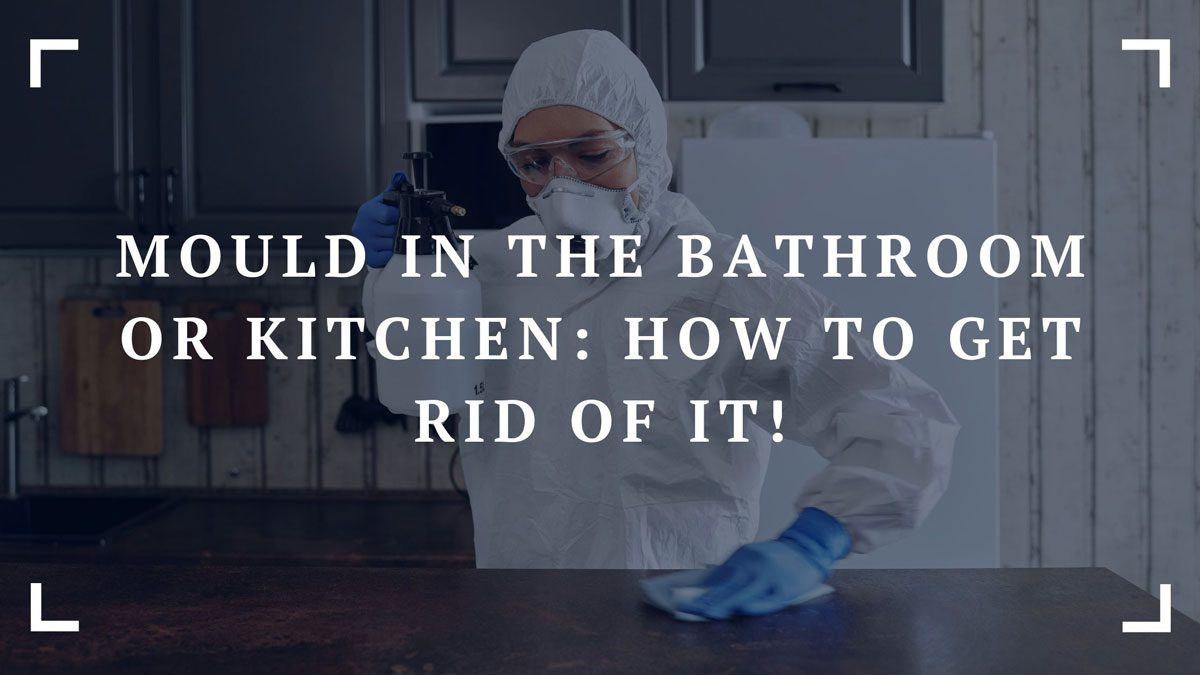What are those black spots between the tiles’ grout in your bathroom? They stink, and you can’t seem to scrub them away! mould in the bathroom or kitchen is a common issue, no matter how stubborn it may appear. With a good mould cleaner, it’s easy to eliminate. In this article, we’ll tell you all about it.

How does mould form?
Mould thrives in places where moisture and warmth come together. That’s the ideal environment for mould to expand. Areas where mould easily forms include the bathroom and kitchen. Moulds spread by releasing tiny spores that are too small to see. These spores can float around in the air, both outside and inside. If these mold spores land on a wet surface inside, they can start to grow. There are lots of different kinds of mold, but all of them need some water or moisture to grow. Mould often starts in places that are hard to clean, such as small corners and the grout between your tiles.
Preparation
To remove mould, you can purchase a mould cleaner at the drugstore or supermarket. However, there’s also a DIY option. Take a spray bottle and fill it with water. Then, dissolve one to two tablespoons of baking soda in it. This is slightly less potent than a mould remover but much more cost-effective. You can easily remove less stubborn mould with this mixture.
Removing mould
Mould isn’t healthy for our respiratory system. When you scrub mould spots, the mould becomes airborne (you’ll smell it), and this can make you sick. It’s advisable to wear a face mask while removing mould. Baking soda can seriously dry out your hands, so wearing cleaning gloves is also a good idea. Spray the mould cleaner or the water and baking soda mixture onto the mould spots and scrub thoroughly. Use a scrubbing sponge for this task. An old toothbrush can be quite handy for the grout between tiles. Once you’ve scrubbed the mould loose, wipe the area twice with clean water and dry it with a kitchen towel.
Preventing mould
In warm and humid spaces that are also poorly insulated, it’s almost impossible to completely prevent mould. The battle against mould will, therefore, never be entirely over. The best thing you can do is to minimize mould’s chances of settling in and spreading. Keep the space as dry as possible by drying the floor immediately after showering or always wiping down the countertop after washing dishes. In the bathroom, it may be wise to leave the door open after using hot water so that the steam can escape the room instead of condensing inside. Address early mould spots immediately to prevent the mould colony from expanding further.
Health Risks Associated with Mould
Mould in your home isn’t just unsightly; it’s a health hazard. Prolonged exposure to mould can lead to respiratory issues, allergic reactions, and in severe cases, can exacerbate asthma. It’s especially harmful to children, the elderly, and those with compromised immune systems. Understanding the health risks associated with mould is crucial for recognizing the importance of timely removal and prevention.
Alternative Mould Cleaning Solutions
While the baking soda solution is effective for minor mould problems, sometimes you need a stronger approach. Vinegar, for instance, is a natural and potent mould killer. A solution of equal parts water and white vinegar can be used in the same way as the baking soda solution. For more persistent mould, hydrogen peroxide or a mixture of bleach and water might be necessary. Remember to always use these solutions with caution and proper ventilation.
Identifying Hidden Mould in Your Home
Mould isn’t always visible. Sometimes, it hides behind walls, under floors, or in ceilings, especially in older homes. Signs of hidden mould include a musty smell, unexplained allergies, and discoloration on walls or ceilings. If you suspect hidden mould, it might be necessary to consult a professional to identify and remove it safely.
Long-Term Mould Prevention Strategies
Besides keeping surfaces dry, consider investing in a dehumidifier for particularly damp areas of your home. Ensuring good ventilation and air circulation can also prevent mould growth. Regular cleaning of high-moisture areas and immediate repair of leaks in roofs, windows, or pipes will significantly reduce the risk of mould formation.
When to Call a Professional
There are situations when DIY mould removal isn’t enough. If the mould covers a large area (more than 10 square feet), or if you have health concerns, it’s better to call in a professional. Professional mould removal services have the necessary equipment and expertise to safely and effectively remove extensive mould infestations.
Staying Ahead in the Battle Against Mould
Mould in your home, particularly in high-moisture areas like the bathroom and kitchen, is more than a cosmetic issue. It poses real health risks and can significantly impact your living environment. By understanding the causes of mould growth and employing both DIY and professional solutions, you can effectively tackle this common household problem.
Remember, the key to mould control is prevention. Regular cleaning, proper ventilation, and moisture control are your best defenses against mould. Whether you choose natural solutions like baking soda and vinegar or opt for commercial mould removers, the goal is to address mould issues promptly and thoroughly.
While DIY methods are effective for minor mould problems, don’t hesitate to seek professional help for larger infestations or if health concerns arise. Ultimately, staying informed and proactive is your best strategy in maintaining a healthy, mould-free home.
In this ongoing battle against mould, knowledge and prevention are your most powerful tools. Stay vigilant and remember, a clean, dry environment is your best defense against the persistent challenge of mould.


